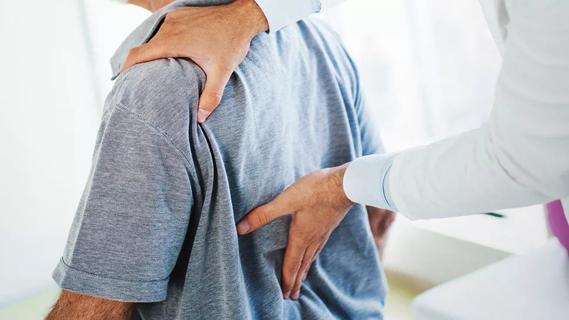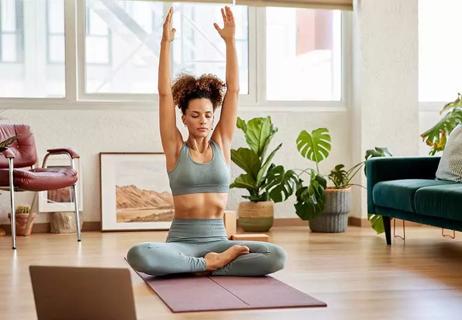A good stretch you don't have to be a superhero to master

If there’s one ailment that everyone can relate to, it’s back pain. While it can come in different forms and different places along our spine and from several different causes, it’s likely we all experience some sort of back pain from time to time.
Advertisement
Cleveland Clinic is a non-profit academic medical center. Advertising on our site helps support our mission. We do not endorse non-Cleveland Clinic products or services. Policy
While there are also a variety of treatments, there are a handful of easy-to-perform movements that can help relieve some tension and aches. And one, in particular, is pretty, well, super: the Superman stretch exercise.
To better understand back pain, the Superman stretch and other ways to take care of your backaches, we spoke to sports physical therapist Daniel Hass, PT, DPT.
“Low back pain is common and, for most people, there is not a known specific pathology, like a vertebral fracture, tumor or infection,” says Dr. Hass.
But there are a few causes of back pain that are common and frequent:
Advertisement
Even if you don’t experience much back pain, though, that doesn’t mean you’re not at risk. According to a 2018 study, says Dr. Hass, the greatest risk factors for low back pain are obesity, smoking, physically demanding jobs and physical and mental comorbidities.
While it seems counter-intuitive, one way to help ease lower back pain is through continued activity and movement. Whether it’s a series of exercises and stretches or directed physical therapy, movement helps loosen and strengthen muscles while being sedentary can lead to them becoming stiff.
It’s all within reason, of course. Some soreness is ok, but you don’t want to do anything to exacerbate your pain. “The general rule is if your pain is mild, and the exercises don’t worsen your symptoms, it’s ok to give it a go,” Dr. Hass says.
“However, if symptoms are persistent or worsen with self-directed exercises,” he adds, “it’s best to seek the advice of a physical therapist who can perform a thorough examination and prescribe a specific rehabilitation program to meet your needs.”
One self-directed exercise that can help is called the “Superman.” A strengthening and stability exercise, the Superman exercise is a low-intensity exercise that can be performed daily, says Dr. Hass. It also strengthens your lower back which can prevent pain. Just be sure to make it part of a more comprehensive routine rather than perform it on its own.
To execute the Superman:
But, Dr. Hass adds, don’t rest and relax yet. “Maintain tension in your muscles, and slowly raise back up to perform another repetition,” he notes. “And it’s important to go slow, and focus on good form as opposed to rushing through the exercise.”
Perform two sets of 12 to 20 repetitions to complete your session.
While it may not be able to make you leap a tall building in a single bound, there’s still plenty of benefits in making the Superman exercise part of your workout routine.
“The Superman exercise is designed to strengthen and improve stabilization of your lumbar and hip extensors,” says Dr. Hass. “Because you’re also raising your shoulders in an ‘I’ formation, it’s also a useful exercise for improving strength and stability in your shoulder girdle and upper back musculature.”
Advertisement
Because this exercise involves a spinal extension, it can strengthen your larger, global extensor musculature, such as the paraspinal muscles (the muscles that run up and down along your spine) and your gluteus maximus (the large muscles that make up your butt). “These muscles,” says Dr. Hass, “are important for global movements like standing and walking.”
“But you’re also still activating smaller, deep lumbopelvic muscles that are important for stabilization,” he adds.
The most important thing to not do with this — and any other exercises — is to work through the pain, especially if you have an acute injury.
“Some injuries may be exacerbated with extension-bias exercises like this one,” says Dr. Hass. “This exercise may potentially make your symptoms worse, so start slow and let pain be your guide.”
If you have numbness or tingling or any pain in the legs (radicular pain), stop and talk to your healthcare provider or physical therapist.
Again, remember to keep your neck in a straight, neutral position. Looking up could cause serious strain to your neck. Dr. Hass recommends placing a folded towel on the ground for you to rest your forehead on.
Additionally, don’t go too fast and don’t use jerky motions. Keep your motions slow, controlled and smooth to get the most out of the exercise and avoid injury.
Advertisement
“It may be advisable to keep the upward movement of this exercise to only a few inches at first, to make sure you maintain good form and don’t over-strain,” Dr. Hass suggests. “And you may want to place a pillow or two under your stomach so you begin in a slightly flexed position.”
The Superman exercise is just one piece of what should be a larger, holistic exercise picture for you. “The biggest piece of advice I can give to help with back pain is to maintain a healthy lifestyle,” Dr. Hass says.
“Stay active,” he adds. “Exercise is effective in reducing low back pain. While it’s not clear what form of exercise is most effective, activity is still the key. Find something active you love and stick with it.”
And, he says, be sure to check in with your healthcare provider or physical therapist to find the approach that’s best for you.
Advertisement
Learn more about our editorial process.
Advertisement

Hanging upside down for any length of time may decompress the tension in your spine

Drinking alcohol can cause nerve pain, dehydration and weight gain, which can all lead to back pain

Your sleep position, immobility, mattress and underlying conditions can all cause morning back pain

Rest may be all you need to get rid of running-related lower back pain

It’s always a good idea to let a healthcare provider know about any back pain you’re experiencing, especially if it results from trauma or persists longer than three months

From physical and biofeedback therapy to nerve ablations and blocks, there are many nonsurgical options for managing back pain

Rest, physical therapy, acupuncture and nerve blocks are just a few ways to find relief

Get moving, use cold packs, and try yoga and stretches to ease back pain

Babies can get congested easily, but you can calm their cough by keeping them hydrated, using nasal drops and running a humidifier

Weight loss may cause loose, sagging skin and muscle loss to your rear

Several conditions, like vitiligo and fungal infection, can cause a loss of pigmentation, leading to white spots or patches on your skin